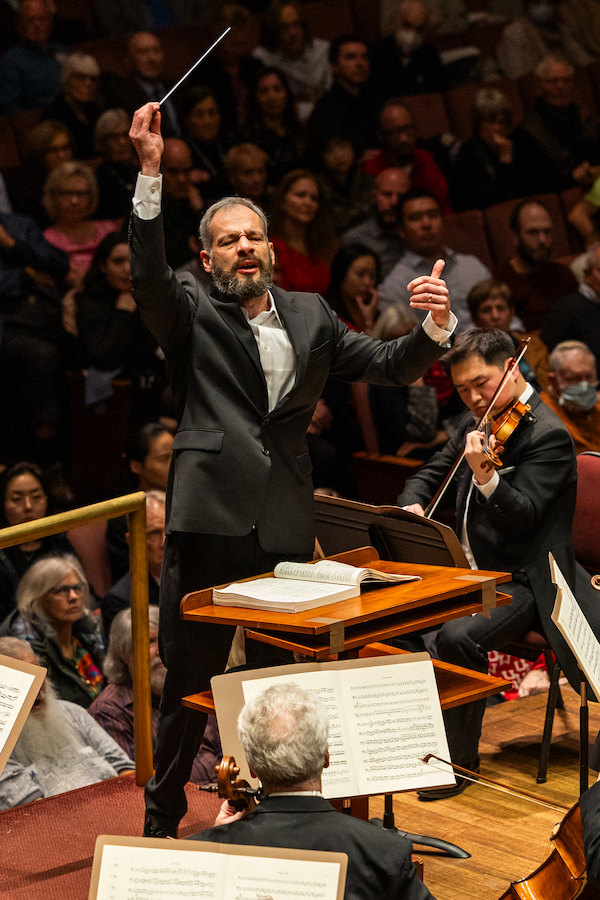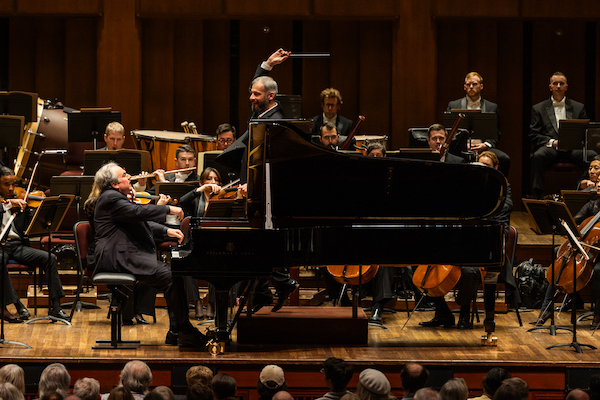Slobodeniouk proves an impressive podium guest in commanding NSO debut

Dima Slobodeniouk conducted the National Symphony Orchestra in music of Brahms and Tchaikovsky Thursday night at the Kennedy Center. Photo: Zach Mahone
Dima Slobodeniouk made a masterful debut at the podium of the National Symphony Orchestra this week. The program he led Thursday night in the Kennedy Center Concert Hall was nothing innovative or unusual in terms of repertoire: just two standard romantic chestnuts, by Brahms and Tchaikovsky. In both works the Russian-born Finnish conductor had the NSO sounding supremely confident and unified.
It was not a local debut for Slobodeniouk: listeners may recall his last guest appearance at the helm of the Baltimore Symphony Orchestra in 2017, which left a similar positive impression. Back then he was serving as chief conductor of the Lahti Symphony Orchestra, where he was replaced by Dalia Stasevska in 2021, and as principal conductor of the Orquesta Sinfónica de Galicia, a post he left last year. In recent years he has been guest conducting all over—including the New York Philharmonic last week. Some enterprising orchestra should really take him off the market if they can.
Yefim Bronfman took the solo part of Brahms’ Piano Concerto No. 2, a work he was scheduled to play with the NSO back in 2018. Not only did he give a magisterial performance of the work’s extensive technical demands, he did so with unsurpassed elegance and collegiality. In the opening of the first movement, he wove his cadenza-like statements around dreamy solos from principal horn player Abel Perreira.

Yefim Bronfman performed Brahms’ Piano Concerto No. 2 with Dima Slobodeniuok leading the NSO Thursday night. Photo: Zach Mahone
With immaculately precise gestures, Slobodeniouk kept the NSO in step with his soloist, pacing the first three movements at genial tempi. Bronfman, a veteran player now in his 60s, revealed a few technical shortcomings here and there, expertly covered, but the musicality of the phrasing remained exceptionally moving. After the distraction of many late arrivals being seated in the hall, the second movement offered subtle voicings from Bronfman, with rich accompaniment from the dominant lower strings.
The slow movement proved everything one could wish from Brahms: ardent solo playing from principal cellist David Hardy, with rhapsodic responses from the piano. An exquisite ensemble rendition all in all, this performance held much in emotional reserve, hinting at hidden depths just below the surface. Pianist and orchestra offered up the finale, surprisingly sunny for Brahms, with understated subtlety at times matched with daring speed.
After going to shake David Hardy’s hand during the extended ovations, Bronfman was convinced to sit again at the keyboard for an encore. Chopin’s Étude Op. 10, no. 12 (“Revolutionary”), performed at an impetuous tempo and with explosive volume, struck the perfect note of defiance and resolution.
Bronfman’s encore made a pleasing link to the second half, devoted to Tchaikovsky’s Fourth Symphony. The horns, followed by the trumpets, gave imperious force to the theme that opens the first movement. Often identified with the idea of fate, this melody returns a number of times to mark structural shifts in the piece. Slobodeniouk guided the NSO expertly through the many changes of tempo and character in this movement, from a moody waltz melody to a more slinking tune with chromatic riffs and back again.
From the opening oboe solo, played poignantly by principal Nicholas Stovall, the slow movement impressed with its subtle rubato pacing. All instruments that took up that melancholy theme had time to shade and place it carefully, thanks to Slobodeniouk’s control of the full dynamic range available from an orchestra. The violins responded with graceful intensity, followed by a final statement from bassoonist Sue Heineman.
The pizzicato strings gave the third movement a delectable lightness, never forcing the sound or the pacing. The woodwinds and then the brass impeccably added their own thematic material, which Tchaikovsky blends together at the movement’s climax. Having held back so much in achieving these subtle results, Slobodeniouk turned on the fire for the finale, taken with exhilarating rapidity and pounding volume. The second theme, based on the Russian folk song “In the Field Stood a Birch Tree,” added just the right nostalgic touch.
The program will be repeated 8 p.m. Friday and Saturday. kennedy-center.org
